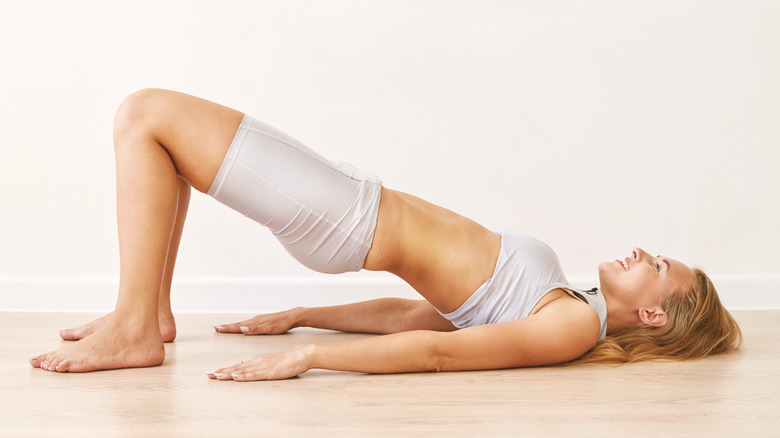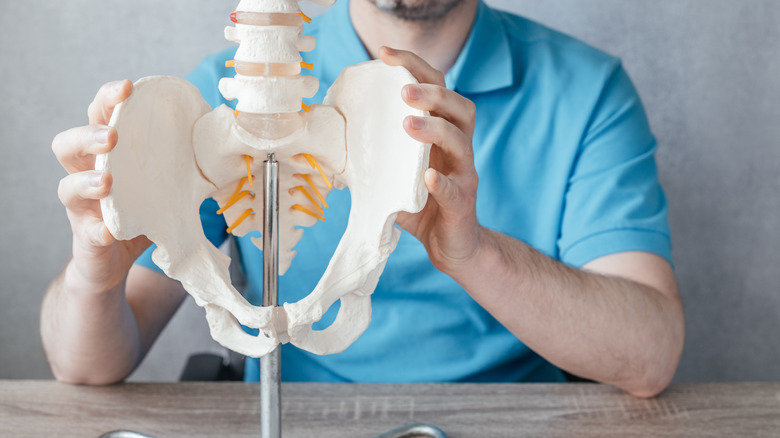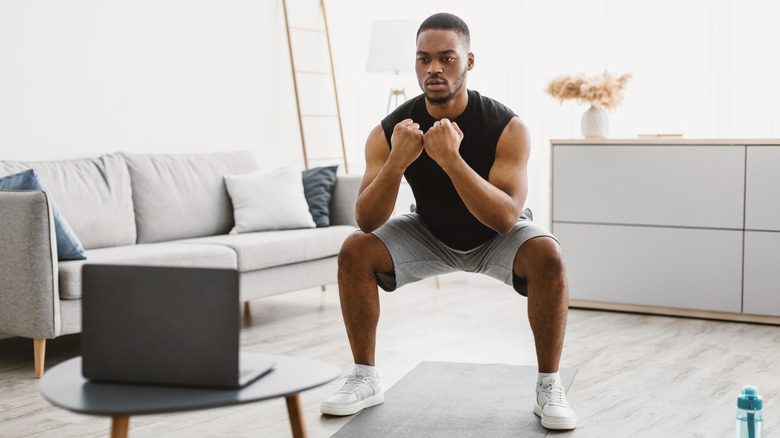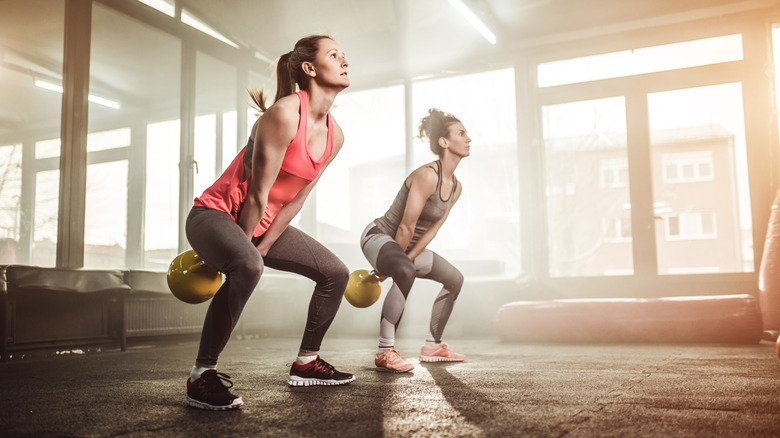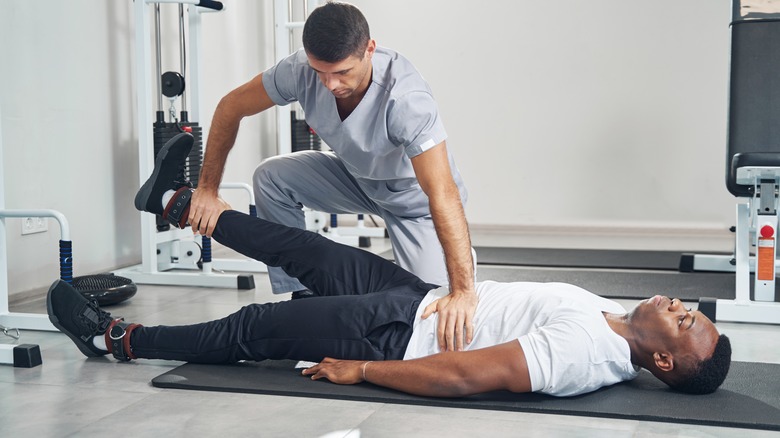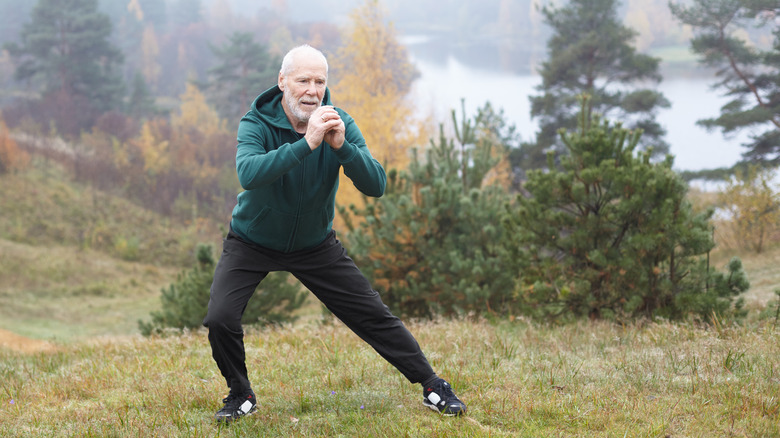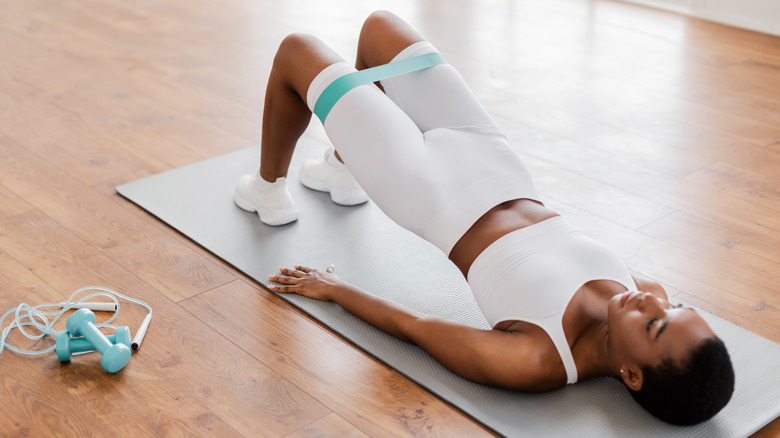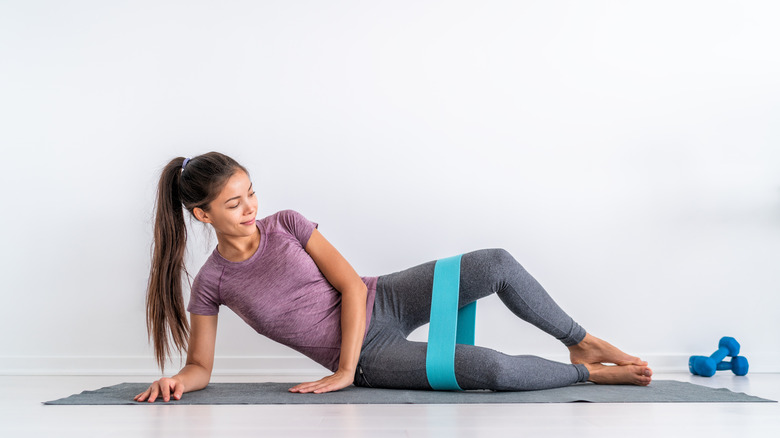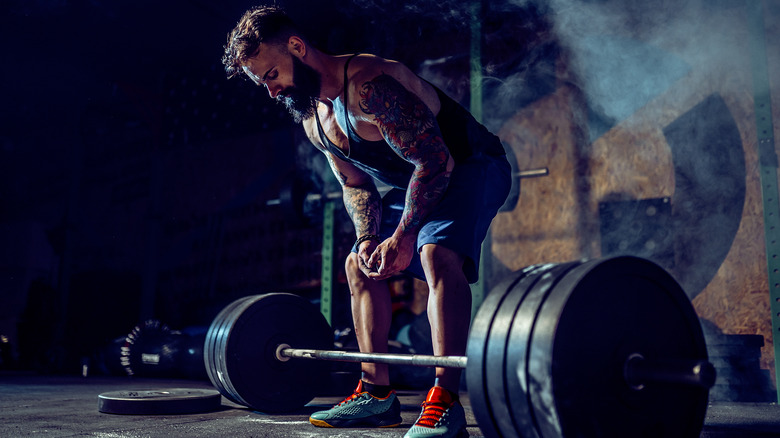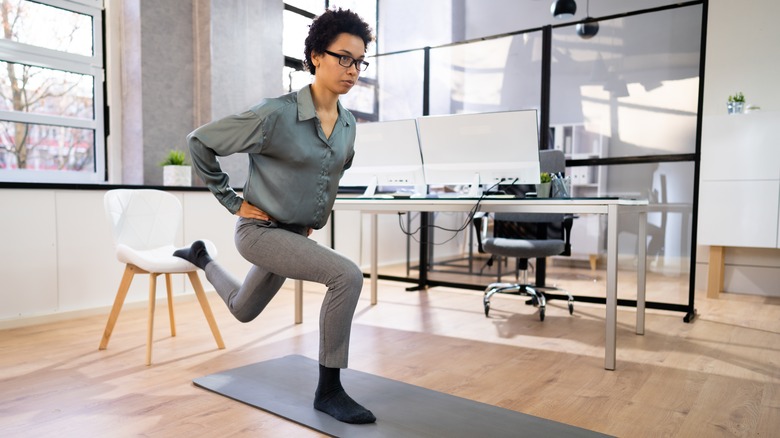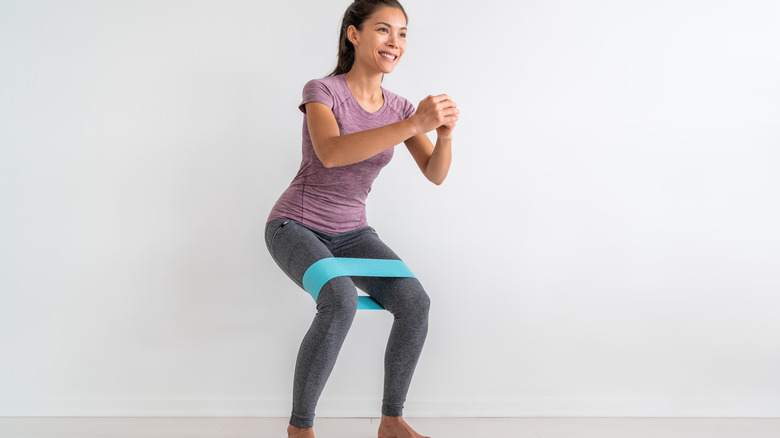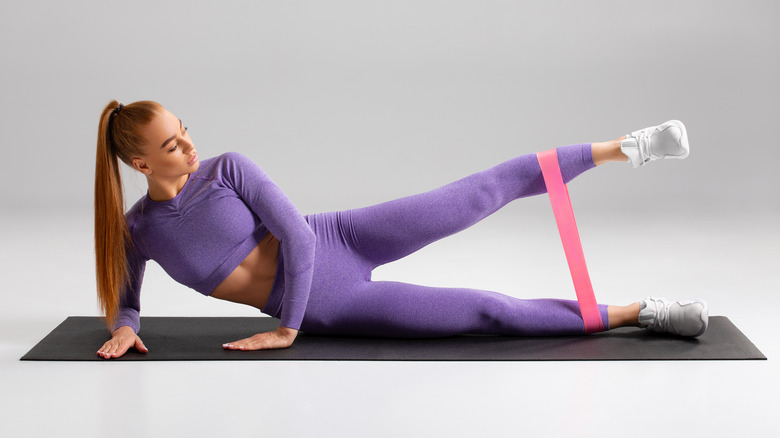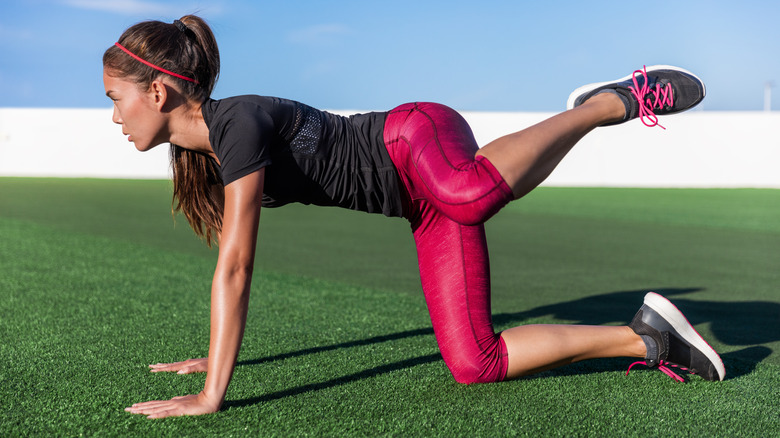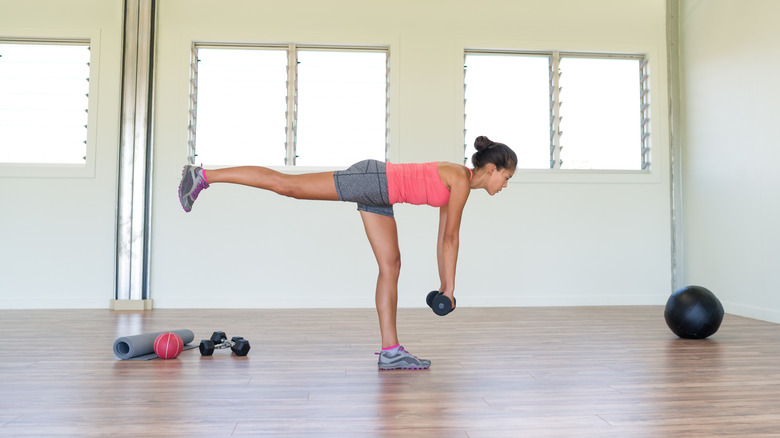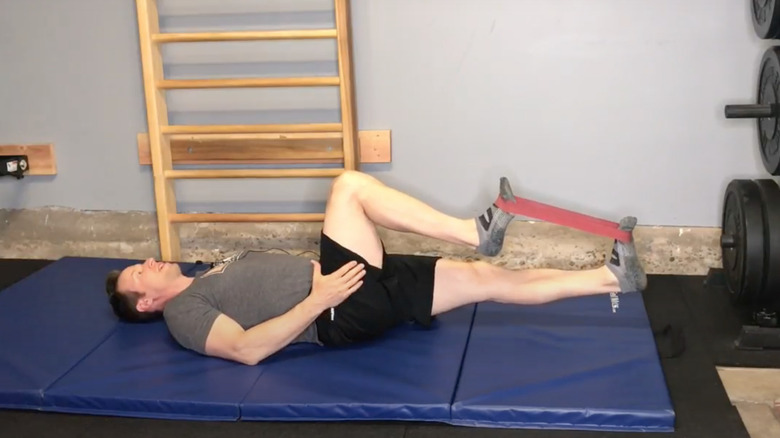The Best Exercises That Will Strengthen Your Hips
Honestly, we can't praise the hips enough. Our hip muscles and bones make up an essential part of our body that's involved in basically all of our day-to-day functions, and it's easy to forget just how much we utilize them, as well as how much they can endure.
"They take on standing stress, sitting stress, and stabilizing stress," certified personal trainer at the Soho Strength Lab Chelsey Wilkens says of the hips (via Health). And over a lifetime, this stress can build to some less-than-desirable consequences. For instance, hip fractures are a common occurrence in older adults, with the U.S. alone seeing approximately 300,000 cases per year. That's why training your hips is so darn important. "Adding strength to the part of your body that gives you the greatest support will improve your ability to move throughout daily tasks without hesitation," advises Wilkens. But unlike muscles like the biceps, which can be trained in isolation, strengthening hips can seem a little more complicated and elusive.
Fear not, though — here at Health Digest, we've put together the ultimate list of exercises that can help you make your hips the strongest they've ever been. Let's warm up and take a look.
Which muscles are part of your hip?
To talk about training the hips, we need to know which muscles we're talking about.
Like many parts of our body, the hips are made up of multiple separate muscles that operate in conjunction with each other to support our range of movement. As KenHub explains, among the muscles that make up our hip section are the gluteal muscles (aka your glutes or your butt muscles), the adductor muscles (which operate inside the hip and the groin area), and your psoas muscles (also known as the hip flexors, which run along the front and center of your body through the pelvic region and help our thighs move up towards our bodies).
All of these muscles work in synchronization to maintain healthy movement in our lower bodies. And when one or more of them is weak or compromised, it can affect both the quality of our workouts and our general day-to-day activities, says certified strength and conditioning specialist Rachel Tavel (via SELF). It's for this reason that keeping the entirety of your hip area strong through a range of exercises is so important.
Squats
Plenty of exercises have tried and failed to knock the squat off its pedestal as one of the best exercises out there. But honestly, it's just that good.
Knocking out the squats helps us in pretty much every movement we do daily. "So many actions can stem from the movements of a squat, from picking up your toddler to loading boxes into the house after a delivery," advises personal trainer Katrina Pilkington (via News24). "If you work to perform squats on a regular basis, using form that is on-point, you're sure to avoid injuries, and build a strong foundation for functional movement." And with our glutes and hip flexors benefitting from squats, it's a great exercise to strengthen our hip area.
To perform a basic squat, stand up straight, with your feet placed around hip-width apart (per Verywell Fit). Maintaining strength through your abdominal muscles, bending your knees, and keeping your back and torso straight, let your hips move back and down. When your thighs are parallel to the ground, pause briefly, and then drive back up to a standing position, activating your glutes to do so. Make sure not to lock your knees at the top. Repeat for as many reps and sets as you require.
Kettlebell swing
With the majority of action seeming to happen upstairs during kettlebell swings, it's easy to assume they're an upper-body exercise. But in fact, kettlebell swings benefit one area of your body in a pretty substantial fashion, provided you're doing them right: your hips.
Kentucky-based EverybodyFights head trainer Matt Veigl agrees. "The kettlebell swing motion is a powerful hip extension that uses your main 'power' muscles—the hips, hamstrings, and glutes," Veigl says to Well+Good. "Focusing on driving the movement from your hips will help maximize hamstring and glute utilization while minimizing reliance on the quads for knee extension."
Therefore, when performing a kettlebell swing, good form is crucial. Begin with your kettlebell grasped in front of you with both hands, with your arms loose and your core activated (per Greatist). Bending your knees and with your butt moving towards the back wall, use the power of your hips to send the kettlebell swinging forward, until it's at chest height. Allow the momentum of the kettlebell dropping to send it back between your legs, as you bend from your hips. Once it swings back forward, send it upwards again, once more activating your hips.
Straight leg raise
With the hip area particularly susceptible to strain and injury, knowing how to gently reintroduce it to exercise and movement following a recovery period is a smart move. To do this, the straight leg raise should be your first port of call. Straight leg raises are a gentle strengthening move that are routinely used by physical therapists to help individuals following a hip or knee replacement, says Verywell Health.
Begin your straight leg raise by lying on your back on the floor with a mat underneath you and your legs extended. Bend one of your legs to bring your foot up to the floor. Then, activating your quad muscles in the straight leg, slowly lift it up until it's elevated to around six inches or so. Hold the position here briefly, and then lower the leg, repeating for around 10 reps before resting. As your hip strength increases, you can add resistance by using a cuff weight, although it's sensible to confer with your physical therapist about at what point you can introduce this to prevent prolonging your recovery.
Lateral lunge
It feels like there are as many lunge variations as days of the year sometimes — and true to form, there's one that'll particularly benefit your hips.
Lunges are excellent exercises for your hips in any variation, as certified strength and conditioning specialist Rachel Tavel explains (via SELF). With the ball-and-socket nature of the hip joint allowing it to move in any direction, strengthening the hips from all angles using a variety of lunges will help keep it protected during a wide range of activities and movements. Lateral lunges are particularly effective in helping support hip abduction and sideways movements with the lower body.
To do a lateral lunge, start in a regular standing position, your hands on your hips and feet shoulder-width apart. Then, instead of stepping forward as you would with a normal lunge, step out to the side with one of your feet. While bending forward at the hips, lower into a lunge over the extended foot. Hold the position there briefly, and then push yourself back to a standing position. To avoid any twisting, make sure that the knee stays in line with the foot and bends over it.
Glute bridge
We can't say it enough, folks: Your butt is part of your hips. Despite the glutes sometimes being treated as an entity in themselves, they perform an essential function in the movement and function of your hip area. Thus, keeping them as strong as the other muscles in the region is important.
The glute bridge is a beginner-friendly exercise. In fact, you've probably been doing a variation of it since you were a little kid, crab-walking around the playground. It comes with a range of modifications, but in its basic form (requiring nothing but the floor), it is a great choice for your home workout repertoire (per SELF).
Doing a glute bridge couldn't be simpler. Simply lie on the floor, with your hands flat by your sides and your legs in semi-supine. Keep your feet flat on the floor. Your heels should be tucked in close to your butt, but not uncomfortably so. Activating your glutes, push your hips up towards the ceiling while engaging your abs, until your body is flat from your knees to your shoulders. Hold the position here briefly, and then slowly lower your butt back to the floor. Keeping your mind on the straight line your body's making at the top of the move and resisting the urge to arch your back too much will help you avoid injury.
Clamshell
Okay, yes. This move might not have the flashiest name in the world. But are you going to forget an exercise called the clamshell? Yeah, we didn't think so.
Aside from its peerless name, the clamshell is a pretty next-level move to strengthen one particular hip muscle, the gluteus medius (per Openfit). Your medial glutes, which run down the outside of your hip and butt, help you stay stable and balanced. They protect your legs, knees, and lower back from strain and injury while aiding in side-to-side motions. We'll take a funkily-named move for benefits like that.
Begin the clamshell by lying on one side, with your hand propped under your head and your knees bent so that they're level with your pelvis, one leg lying on top of the other. Keeping your feet firmly connected, lift the upper leg as high as it will go, making sure that the lower leg doesn't lift off the ground or your hips don't rotate. Squeeze in your glutes at the highest point, and then slowly lower your upper leg back down to meet your lower one. To add further resistance and improve your strength-building efforts, you can also do the clamshell with a resistance band wrapped around your lower thighs.
Power clean
Traditional bodybuilding movements tend to use multiple muscle groups to generate power, so it's little surprise that the hips are involved in a lot of them. The power clean is one such move where your hips do a lot of the work, helping build a stronger center.
"There isn't a much better developer of strength and power than the clean," states Movable Muscle head coach Tom Wright to Coach Magazine, while highlighting its benefits for the timing, structural integrity, and coordination of the body. "Explosive power primarily comes from the hip drive, which is the crux of all weightlifting movements. It teaches you to create whole-body tension and work your body as a unit." Seriously, does it get better than that?
While bodybuilding exercises may seem intimidating to the casual exerciser, performing a power clean can be simpler than you think. As a complex move, though, focus and mastery of the movement are essential to minimize injury risk. With your feet at shoulder width and your barbell in front of you, drop into a squat and grab the bar, your palms facing towards your feet (per Verywell Fit). Keeping your back and spine straight, stand up, lifting the bar with you. Then, scooping the hips forward, pull the bar up, elbows coming forward, and catch the bar on your shoulders with your arms positioned underneath. Finally, lower the weight to the ground.
Bulgarian split squat
For those who like their squats with a little more hip action, this move is for you. The Bulgarian split squat is a supreme squat variation that not only builds up glute and hip flexor strength but also helps to improve coordination, according to Men's Health.
Another particular bonus of the Bulgarian split squat is how many muscles it helps to build around your core and hips in addition to your larger ones, thanks to the back leg remaining inactive. "This is challenging from a stability point of view, and engages most of the 35 muscles that make up your core, specifically the small stabilizers around the hips and waistline," Dublin-based personal trainer John Belton says.
The Bulgarian split squat takes a little practice to get right, so be ready to persevere. Standing in front of an exercise bench or chair, place one leg on the bench behind you, with the top of your foot facing down. With the forward-facing leg, move down into a squat position, so that your stabilizing back leg's knee almost connects with the ground. Use the front foot to push back up to standing, and repeat for as many four sets of 12 reps, resting in between them.
Lateral walk
The muscles that form the sides of your hips can be harder to activate and train, with many weight-training moves (like regular squats and lunges) operating on a forward plane of motion. With a lateral walk, you can target your hip abductors and gluteus medius, with the improvement of their strength helping you to avoid knee injury and improve stability and balance (per Verywell Fit). These muscles are especially susceptible to weakness or tightness in folks who spend much of their days sitting down at a desk, so working on them specifically is important.
The lateral walk is best done with a resistance band to improve activation. Place a resistance band just above your ankles, stretched between your legs. With your feet around hip-width apart, move into a semi-squat position. Make sure you don't rock back too far or too forward. Step one leg out to the side, and take a few steps in one direction, feeling your hip muscles activate as you do so. Step back the other way and repeat for 30-60 seconds. Adding stronger resistance bands will fire up your hip muscles even further.
Side leg raise
Focusing on your hip abductors has benefits beyond your hip strength. "When you increase the activation of those two other smaller muscles, they help you activate the rest of your core and your pelvic stabilization systems," advises certified personal trainer and NYC-based Body Space Fitness coach Alicia Jamison (via SELF).
The side leg raise is an easy and accessible move that can help you gain abductor strength — and the best part is, you can do it when you have a spare minute. Standing with your legs shoulder-width apart, place your hands on your hips, then lift one of your legs out to the side while balancing on the other foot (per Healthline). At the top of your range of movement, slowly lower your leg back to the floor and repeat for 12 reps on each side. To quote the legendary Ina Garten, how simple is that?
The side leg raise can also be performed when lying on your side with your head propped on your arm. Keep your legs straight and stacked on one another, and raise one leg upwards to the side. If you're doing the move lying down, be aware of when your lower back or oblique muscles start to activate during the move, as that's usually a sign that your leg is being raised too high. Keep your core engaged to combat too much back involvement.
Fire hydrant
Okay, so we'll be the first people to say it here: The fire hydrant isn't the most elegant move out there. Any exercise named after a dog doing its business is probably not going to be the most graceful. But what it lacks in grace, it makes up for in hip strengthening, with the move hitting your smaller muscles in the area, as well as your larger glute muscles and your core (per Women's Health). Talk about efficiency, right?
Envisaging the inspiration for the fire hydrant's name will probably give you a clue as to how to do it, but we'll talk you through it nonetheless. Begin on your hands and knees, with all four limbs aligned under your shoulders and hips. Activating your core and bringing it in, take one leg out to the side, raising it until it's at hip level. Lower your knee back to the floor to complete a rep. If you're beginning with less mobility in your hips, you may not be able to extend your leg too far out — and that's okay! Just take it slowly and gently. Over time, your hips should loosen and strengthen, giving you more range of motion.
Single leg Romanian deadlift
The combination of the words "single leg Romanian deadlift" may have your eyes widening in fear. Despite the complexity of its name, however, this is a move that's worth mastering.
The single leg Romanian deadlift works out your posterior chain muscles (like your hamstrings and glutes), which operate with your hip to support you in your everyday movements, says Johnson Fitness. To add to that, the move also works your core, adding further stability and postural support. Additionally, the unilateral nature of the move helps to improve overall coordination.
Focusing on balance is key to nailing the single leg Romanian deadlift. Begin with your feet hip-width apart and with softness in your knees. With control, allow one of your legs to move backward and off the ground, bending the knee of the leg still connected to the floor a little more. While your elevated leg moves back, hinge at your hips to move your upper body forward. Once both your raised leg and core are parallel with the ground, activate through the hips and glutes, and return your body to standing. If you're new to this move, it might be worth practicing without weights first, and then introducing weights slowly to perfect your form.
Banded psoas march
Your hip flexors are vital to helping your legs lift towards your core, and tightness in your flexors can lead to a range of mobility issues, says Verywell Fit.
The banded psoas march helps to target your psoas major muscle and the other muscles that make up your hip flexors, and is frequently used in rehabilitation programs to help your hips back to good health. A banded psoas march starts by standing up or lying on your back, with a resistance band around the balls of your feet or toes. Slowly bring one of your knees up until it's around hip level (as though you're marching, hence the name), making sure to keep your core activated as you do so. Return your leg to the original position, and repeat with the other leg. Do around ten reps on each side.
Resistance bands can add too much difficulty to hip flexor exercises. Thus, for those who are seeking hip flexor training more gently, hip marching has a similar range of movement. Start by sitting in a chair with your feet flat on the ground, and lift one of your knees as high as your range of movement will allow (per Eldergym Fitness for Seniors). Lower your leg, and repeat with the other leg, again for ten reps on each side (or however many you're able to do).

